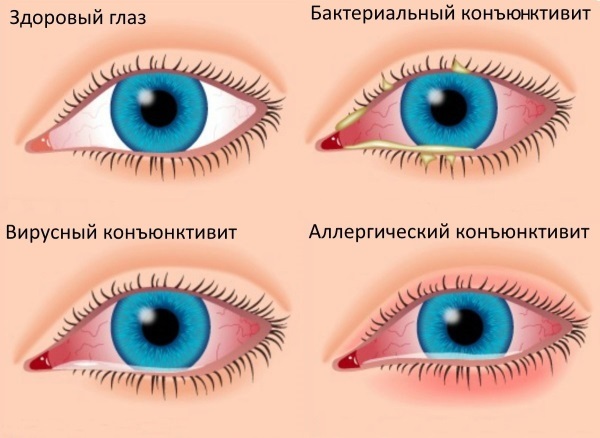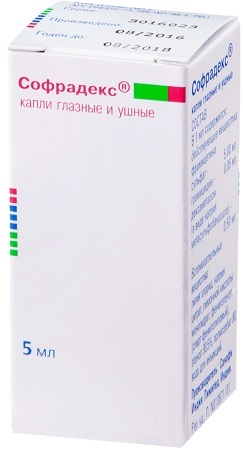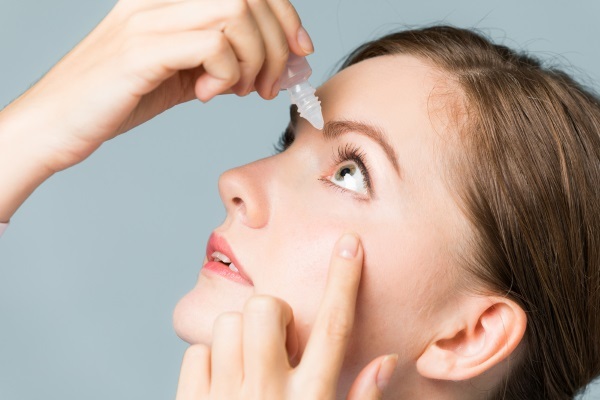To combat ocular infections and the prevention of complications apply different eye drops. The composition of these antibacterial agents are antibiotics.
The content of the article:
- 1 Antibiotics for eye diseases
- 2 testimony
- 3 Contraindications
- 4 Side effects
-
5 The best drugs for adults
- 5.1 Normaks
- 5.2 Floksal
- 5.3 Tobrex
- 5.4 Signitsef
-
6 List of effective remedies for children
- 6.1 Sofradeks
- 6.2 Vitabakt
-
7 Eye drops with a broad-spectrum antibiotic
- 7.1 tsiprolet
- 7.2 chloramphenicol
- 8 Use during pregnancy
- 9 Video of eye drops
Antibiotics for eye diseases
With eye diseases antibiotics may be used in the form of eye drops. They act on the pathogen. Some antibiotics stops the growth and reproduction of pathogenic microorganisms, cause the death of other infectious agents.
Eye drops with an antibiotic has the following advantages:
- they have few contraindications;
- rarely cause adverse reactions, they have a small degree of absorption, however, they almost do not cause undesirable systemic effects;
- many of them have a wide spectrum of action;
- there are drugs which have no age limit;
- available medicines that are allowed during pregnancy.
testimony
Antibacterial agents are recommended for ophthalmic infections of bacterial origin, such as:
- Conjunctivitis - inflammation of the conjunctiva;

- keratitis - corneal lesion;
- Blepharitis - an infectious disease of the lower or upper eyelid;
- barley - suppurative inflammation of the sebaceous follicle, wherein increasing eyelash;
- anterior uveitis - an inflammation of the iris and ciliary body;
- dacryocystitis - purulent inflammation of the lacrimal sac.
About the beginning of the infection may indicate the following features:
- pain, stinging, itching, burning and discomfort in the eyes;
- impaired vision;
- edema of the eyelids;
- mucopurulent discharge from the eye;
- sticking eyelids and eyelashes after sleep;
- photophobia;
- increased tear production;
- redness of the eye;
- gluing eyelashes;
- local redness and thickening of the ciliary edge of the eyelid (these symptoms are under barley).
Typically, when bacterial infection affects only one eye.
When these symptoms is suspected ocular disease of bacterial origin and their recommended antimicrobials. These dosage forms are prescribed for the prevention of infectious and inflammatory diseases after injuries, surgical therapy, laser eye correction.
Contraindications
All antibacterial drops can not be used if you are hypersensitive their composition. Appointment of eye diseases of viral etiology is usually useless. But their use in ocular infections of fungal origin may cause disease progression and worsening of the patient's state of health.
Independently determine the causative agent is not possible, so when the signs of the disease need to see a doctor, who will determine the nature of the disease.
Seek medical attention is necessary if from the moment of the use of antibacterial eye drop took 72 hours, but the positive dynamics is not observed. In addition, depending on the particular drug he may have its contraindications that need to clarify in the official statement.
Side effects
Eye drops with antibiotics can cause allergies, the appearance of which you want to cancel the medication and consult your doctor for further adjustments regimens.
After instillation may experience local adverse reactions:
- itching, burning, pain in the eyes;

- redness connecting shell;
- eyelid edema.
Some eye drops can cause photophobia, tearing, foreign body sensation in eyes, occurrence of an unpleasant taste in the mouth, reduce visual acuity, corneal lesion development superinfection.
If not completely undergo therapy, they can appear microorganisms resistant to antibiotics.
The best drugs for adults
The pharmaceutical industry produces the following products for adults:
- Normaks;
- Floksal;
- Tobrex;
- Signitsef.
Normaks
Normaks as a main component contains norfloxacin, which is a fluoroquinolone antimicrobial agent. The drug has a broad spectrum of activity, which can be used for bacterial ocular infections in patients older than 18 years, except for women who are pregnant and breastfeeding.
The drug need to apply 1 or 2 drops into the affected eye 4 times a day. If the infection is difficult, in the first day of the medication can be instilled every 2 hours.
Once symptoms of the disease will be, the drug need to dig further for 2 days. When trachoma medication prescribed to 2 drops in each eye. Multiplicity instillation per day can vary from 2 to 4 times, and the treatment lasts from 1 to 2 months.
medication treatment can cause the following negative effects:
- nausea, heartburn, not eating, indigestion, abdominal pain;
- pain in the head, weakness, anxiety, irritability, trouble sleeping, dizziness;
- allergy.
Floksal
Floksal contains ofloxacin as the main component, to which many microorganisms are sensitive, so it can use in ocular bacterial infections in adults and children, with the exception of women who bears a child, or feed feeding.
The medicine you need to apply 1 drop twice-four times a day for a maximum of 14 days. The therapy may be allergic, eye problems, dizziness.
Tobrex
Therapeutic effect of tobramycin Tobrex explained. It is an antibiotic of the aminoglycoside, which is in the form of eye drops can be used in patients older than 1 year at ophthalmic infections. The drug is not recommended for women in the state and breastfeeding.
Schema therapy is selected individually depending on the severity of the infection:
| The severity of the disease | dosing Schedule |
| Severe course of infection | Bury medication need 2 drops every hour. As subsiding inflammation reducing amount of instillation. |
| The disease is mild to moderate severity | The drug need to apply 1 drop every 2 or 4 hours. |
Duration of therapy physician selected individually, it can last up to several weeks.
drug treatment can cause a number of undesirable effects, such as:
- headaches;
- allergy;
- eye problems.
During therapy with eye drops Tobrex keep in mind that may cause cross-resistance with other aminoglycosides.
Besides Tobrex commercially available drug Tobrex 2. This is a long-acting drug, which can be instilled 1 drop twice a day. If the infection is serious, then the multiplicity instillation can be increased up to 4 times a day. In addition, unlike Tobrex drops Tobrex 2 allowed for pregnant and lactating patients.
Signitsef
Signitsef eye drops contain as a main component an antibiotic levofloxacin. This antibacterial agent of the fluoroquinolone.
In direct contact with the active ingredient susceptible thereto: streptococci, staphylococci, gonococci, Pseudomonas, Haemophilus influenzae, Moraxella catarrhalis, Chlamydia.
The medicine can be used for eye diseases caused by these microorganisms in patients older than one year, except in the situation of women and breast-feeding.
During the first 48 hours of preparation need to bury 1-2 drops every 2 hours, up to 8 times per day. Next multiplicity instillation should be reduced to 4 times per day. The duration of treatment is determined individually by the oculist, and usually it is 5 days.
The drug is well tolerated, but sometimes it can cause adverse reactions such as:
- eye problems;
- runny nose;
- allergy;
- headaches.
List of effective remedies for children
Eye drops with antibiotic use in pediatric patients based on their composition.
In pediatric practice, the following may apply:
- Sofradeks;
- Vitabakt;
- Baktavit.
Sofradeks
Sofradeks is a combined drug.
The therapeutic effect is due to the following components of it:
- Framycetin sulphate. By its very nature it is an aminoglycoside. To it susceptible staphylococci, Escherichia coli, Proteus, dysentery bacillus. Resistance in bacteria to aminoglycoside develops slowly.
- Gramicidin. Antibiotic stops the growth and proliferation of staphylococci, streptococci, anaerobic bacteria.
- Dexamethasone. It GCS, which suppresses inflammation and allergy, has a desensitizing effect.
When backfilling Sofradeks are pain, burning, photophobia, lacrimation.
The drug is contraindicated in infants.
In addition, it can not be, if the patient is diagnosed the following pathologies:
- intolerance to the drug composition;
- erosion of the cornea and scleral thinning;
- viral, fungal, purulent-inflammatory diseases of the eye;
- oftalmotuberkulez;
- high intraocular pressure;
- trachoma.
Sofradeks prohibited during the period of gestation and lactation.
If the disease is strongly expressed, the drug need to bury every hour 1-2 drops. In less severe disease the drug is recommended to bury every 4 hours. therapy should not be more than a week. Only in extreme cases the doctor can extend the use of the drug.
drug treatment can cause some negative reactions
- allergy;
- glaucoma;
- clouding of the lens;
- mycosis;
- thinning of the cornea or sclera, with subsequent rupture.
Because of the risk of adverse reactions during prolonged therapy is necessary to measure the intraocular pressure, to undergo regular eye check-ups in order to timely detect cataracts and athlete's foot.
Vitabakt
Vitabakt contains as active component pikloksidina dihydrochloride. This antimicrobial agent, which are sensitive Staphylococcus, Streptococcus, Escherichia and Bacillus subtilis, Klebsiella, Proteus, Shigella, Chlamydia, Salmonella typhus. medication also causes the death of certain viruses, and fungi.
Medication has no age restrictions, but it can not be in the position of women and nursing mothers.
Schema therapy optometrist selected individually depending on the indication:
| Indications | dosing Schedule |
| bacterial infections | Bury need 1 drop of from 2 to 6 times a day for 10 days. If the doctor deems it necessary, it may extend the course of therapy. |
| Prevention of postoperative complications | To reduce the risk of postoperative infections, the drug need to instill 1-2 drops before surgery. After surgery, the drug should be instilled 1 drop 3 to 4 times a day. |
Complete analog preparation is Vitabakt Baktavit means.
Eye drops with a broad-spectrum antibiotic
When it is not possible to identify the causative agent of disease, prescribe broad-spectrum antibiotics.
tsiprolet
Tsiprolet represents Indian medicament therapeutic effect of it is explained ciprofloxacin. This antimicrobial agent, which relates to fluoroquinolones. To him susceptible Gram-negative and Gram-positive organisms, including those that are not are the aminoglycosides, tetracycline antibiotics, cephalosporin and penicillin.
Drug resistance occurs slowly. Tsiprolet can be used for the treatment and prevention of bacterial ocular infections in patients older than 1 year.
Medication is contraindicated for women in the state and supporting breastfeeding.
Be wary Tsiprolet need to register at the following pathologies:
- atherosclerosis of cerebral vessels;
- convulsions;
- disorder of brain blood supply.
Dr. regimens are selected individually depending on the diagnosis and the severity of the clinical picture:
| Diagnosis | dosing Schedule |
| eye infections | The drug need to apply 1 or 2 drops in each eye. If the infection is serious, the drug must be instilled every 2 hours. In mild and moderate disease course have to dig medicine every 4 hours. Once signs of the disease begin to weaken, the multiplicity instillation should be reduced. |
| Bacterial corneal ulcer | First, the drug must drip 1 drop every 15 minutes. for 6 hours, then the medicament is to bury every half hour during waking hours. On day 2 drug instilled 1 drop every hour during wakefulness. Beginning 3 days, the medicament must apply 1 drop of 1 every 4 hours. The course of treatment should last for 2 weeks. If the cornea has not healed after this time, the duration of treatment can be continued. |
chloramphenicol
Chloramphenicol comprises chloramphenicol, which stops the growth and proliferation of pathogenic microorganisms, i.e. the drug has a bacteriostatic action. The drug is characterized by a wide spectrum of antibacterial activity, but he has a lot of contraindications.
It is prohibited in the following pathologies:
- suppression of bone marrow function;
- dysfunction of the liver and kidneys;
- lack of G-6-PDG;
- pirroloporfiriya.
Chloramphenicol is contraindicated in women drops in state and breastfeeding. It can not be babies who are under 28 days.
Young children need medication instilled with caution.
In addition, it should be with caution to prescribe to people who have been previously treated with cytostatics, radiotherapy or have dermatologic diseases such as athlete's foot, eczema, psoriasis.
Regardless of age drug prescribed by 1-2 drops of 4 to 6 times per day. Typically, the treatment course is 1 week. If necessary, the ophthalmologist may extend the treatment up to 21 days.
But we must remember that in the long-term treatment there is a risk reduction in the number of platelets, red blood cells and white blood cells, decrease in hemoglobin.
Also increases the likelihood of these adverse reactions, if the patient undergoes radiotherapy, receives sulfa and cytostatic drugs that inhibit the formation of blood and inhibit metabolism liver. Because of the risk of bone marrow suppression activity during therapy need periodic blood tests to detect abnormalities in time.
Chloramphenicol should not be instilled while medicines containing erythromycin, clindamycin, lincomycin, penicillin and cephalosporins, since these combinations there is a weakening of therapeutic actions.
Use during pregnancy
Eye drops with an antibiotic during gestation is extremely undesirable.
You may use the drops based on moxifloxacin, such as:
- Vigamoks;
- Maksifloks;
- Bivoksa VM;
- Moxifloxacin-Optic.
Moxifloxacin belongs to the 4th generation fluoroquinolones, which causes the death of most Gram-positive and Gram-negative bacteria, including acid-resistant and atypical microorganisms.
The drug has no effect on the pathogenic agents which are sensitive to other fluoroquinolones. But he has not been cross-resistance with drugs tetracycline and aminoglycoside series, macrolides.
based on moxifloxacin drops can be used in patients older than one year for bacterial ocular infections, including during pregnancy and lactation.

Bury medication need 1 drop three times a day. Symptoms of the disease are on the 5th day of therapy, but it is necessary to continue for another 48-72 hours. If, after 5 days of treatment is observed positive dynamics, it is necessary to revise the scheme of therapy.
Eye drops containing moxifloxacin may cause the following adverse effects:
- anemia;
- headaches, dizziness, sensitivity;
- dyspnea;
- palpitations;
- elevated levels of liver enzymes;
- nausea, vomiting;
- discomfort in the nose;
- taste alteration, feeling of a foreign body in the throat;
- pain in the pharynx and larynx;
- allergy;
- eye problems.
Given the large variety of drugs for the treatment of eye infections, the treatment should drop pick ophthalmologist with the pathogen and the nature of the disease. All of these means include in their composition antibiotics, so they should not be used without a doctor's prescription.
Registration of the article: Vladimir the Great
Video of eye drops
Lotions and eye drops:



